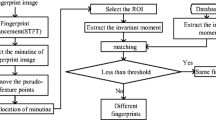Abstract
A fingerprint feature extraction step represents the success key of the fingerprint verification process. In a matching step, the good processing of those features would generate a measure that reflects more accurately the similarity degree between the input fingerprint and the template. In our study, we propose a novel fingerprint feature extraction method based on the Curvelet transform to reduce the dimensionality of the fingerprint image and to improve the verification rate. Like all extractors, the features which are generated by the Curvelet transform are usually imprecise and reflect an uncertain representation. Therefore, we proposed to analyze these features by a possibility theory to deal with imprecise and uncertain aspect in our novel fingerprint matching method. Thus, this paper focused on presenting a novel fingerprint features extraction method and a novel matching method. The features extraction method consists of two main steps: decompose the fingerprint image into a set of sub-bands by the Curvelet transform and extract the most discriminative statistical features of these sub-bands. A possibility based representation of those statistical features would be achieved by a possibility theory. So, the proposed fingerprint matching method is based on the use of the possibility theory as a global framework, including knowledge representation (as a possibility measure); in order to build a possibility fingerprint knowledge basis to be exploited in order to make a fingerprint verification decision. An extensive experimental evaluation shows that the proposed fingerprint verification approach is effective in terms of fingerprint image representation and possibility verification reasoning.





Similar content being viewed by others
References
Bhanu B, Tan X (2003) Fingerprint indexing based on novel features of minutiae triplets. IEEE Trans Pattern Anal Mach Intell 25(5):616–622
Boer JD, Bazen AM, Gerez SH (2001) Indexing fingerprint database based on multiple features. In: Proceedings of the ProRISC, 12th annual workshop on circuits, systems and signal processing
Candes E (1998) Ridgelets: theory and applications. Ph.D. thesis, Department of statistics, Stanford University
Candès E, Demanet L, Donoho D (2006) Fast discrete curvelet transforms. Multiscale Model Simul 5(3):861–899
Candès E, Donoho DL (1999) Curvelets—a surprisingly effective nonadaptive representation for objects with edges. In: Cohen A, Rabut C, Schumaker LL (eds) Curve and surface fitting: Saint-Malo 1999. Vanderbilt University Press, Nashville
Chikkerur S, Govindaraju V (2005) Fingerprint image enhancement using STFT analysis. International Workshop on Pattern Recognition for Crime Prevention, Security and Surveillance, ICAPR
Dubois D, Prade H (1985) Thèorie des possibilités. Masson, Paris
Dubois D, Prade H (1988) Representation and combinaison of uncertainty with belief functions and possibility measures. Comput Intell 4:244–264
Guesmi H, Trichili H, Alimi AM, Solaiman B (2012) Curvelet transform-based features extraction for fingerprint identification. 7th IEEE International Conference of the Biometrics Special Interest Group (BIOSIG 2012), Darmstadt, Germany. Sept 06-07
Guttman A (1984) R-trees: a dynamic index structure for spatial searching. In: Proceedings of the ACM SIGMOD international conference on management of data. pp. 47–57
Holzinger A, Stocker C, Peischl B, Simonic KM (2012) On using entropy for enhancing handwriting pre-processing. Entropy 14(11):2324–2350
Jain AK, Prabhakar S, Hong L (1999) A multichannel approach for fingerprint classification. In: IEEE Transactions On Image Processing 21(4)
Jain AK, Prabhakar S, Hong L, Pankanti S (1999) FingerCode: a filterbank for fingerprint representation and matching. Proc IEEE Comput Soc Con/ Compurer Vision Partern Recognirion (CVPR) 2:187–193
Jeon B, Landgrebe D (1999) Decision fusion approach for multitemporal classification. IEEE Trans Geosci Remote Sens 37(3):1227–1233
Liu M, Jiang X, Kot AC (2007) Efficient fingerprint search based on database clustering. Pattern Recogn 40(6):1793–1803
Maio D, Maltoni D, Jain AK, Prabhakar S (2003) Handbook of fingerprint recognition. Springer, New York
Nanni L, Lumini A (2006) Two-class fingerprint matcher. Pattern Recogn 39(4):714–716
Nanni L, Lumini A (2007) A hybrid wavelet-based fingerprint matcher. Pattern Recogn 4011:3146–3151
Rahman A, Fairhurst M (1998) A novel confidence-based framework for multiple expert decision fusion. Proceedings of the conference BMVC’98. University of Southampton, Royaume-Uni
Ross A, Jain A, Reismanb J (2003) A hybrid fingerprint matcher. Pattern Recogn 36:1661–1673
Sasikala KR, Petrou M (2001) Generalised fuzzy aggregation in estimating the risk of desertification of a burned forest. Dans Fuzzy Sets Syst 118(1):121–137
Semler L, Dettori L (2006) Curvelet-based texture classification of tissues in computed tomography. Proceedings of IEEE International Conference on Image Processing, Atlanta, GA, 8-11 Oct
Solaiman B, Pierce LE, Ulaby FT (1999) Multisensor data fusion using fuzzy concepts: application to land-cover classification using ERS-1/JERS-1 SAR composites. IEEE Trans Geosci Remote Sens 37(3):1316–1326
Tang T (2012) Fingerprint recognition using wavelet domain features. 8th International Conference on Natural Computation (ICNC 2012), Chongqing, Sichuan, China, 29 May - 31 May
Yager RR (1982) Levels sets for membership evaluation of fuzzy subsets. In: Yager RR (ed) Fuzzy sets and possibility theory: recent developments. Pergamon Press, Oxford, pp 90–97
Yang JC, Park DS (2008) A fingerprint verification algorithm using tessellated invariant moment features. Neurocomputing 71:1939–1946
Zadeh LA (1965) Fuzzy sets. Inf Control 8(3):338–353
Zadeh LA (1978) Fuzzy sets as a basis for a theory of possibility. Fuzzy Sets Syst 1:3–28
Zahzah E (1992) Contribution à la Représentation des connaissances et à leur utilisation pour l’Interprétation Automatique des Images Satellite, Thèse de 3ème cycle présentée devant l’Université Paul Sabatier. Toulouse
Author information
Authors and Affiliations
Corresponding author
Rights and permissions
About this article
Cite this article
Guesmi, H., Trichili, H., Alimi, A.M. et al. Fingerprint verification system based on curvelet transform and possibility theory. Multimed Tools Appl 74, 3253–3272 (2015). https://doi.org/10.1007/s11042-013-1785-1
Published:
Issue Date:
DOI: https://doi.org/10.1007/s11042-013-1785-1




